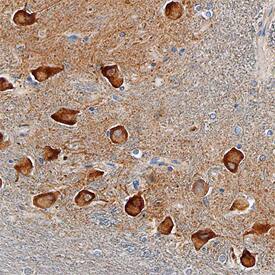Human SorCS2 Antibody
R&D Systems, part of Bio-Techne | Catalog # AF4238

Key Product Details
Species Reactivity
Human
Applications
Immunohistochemistry, Western Blot
Label
Unconjugated
Antibody Source
Polyclonal Sheep IgG
Product Specifications
Immunogen
NS0-derived recombinant human SorCS2
Ser70-Gly1078
Accession # Q96PQ0
Ser70-Gly1078
Accession # Q96PQ0
Specificity
Detects human SorCS2 in direct ELISAs and Western blots. In direct ELISAs and Western blots, approximately 20% cross-reactivity with recombinant mouse (rm) SorCS2 is observed and less than 1% cross-reactivity with recombinant human (rh) SorCS1 and rhSorCS3 is observed.
Clonality
Polyclonal
Host
Sheep
Isotype
IgG
Scientific Data Images for Human SorCS2 Antibody
Detection of Human SorCS2 by Western Blot.
Western blot shows lysates of human kidney (medulla) tissue. PVDF Membrane was probed with 1 µg/mL of Sheep Anti-Human SorCS2 Antigen Affinity-purified Antibody (Catalog # AF4238) followed by HRP-conjugated Anti-Sheep IgG Secondary Antibody (Catalog # HAF016). A specific band was detected for SorCS2 at approximately 120 kDa (as indicated). This experiment was conducted under reducing conditions and using Immunoblot Buffer Group 8.SorCS2 in Human Brain.
SorCS2 was detected in immersion fixed paraffin-embedded sections of human brain (medulla) using Sheep Anti-Human SorCS2 Antigen Affinity-purified Polyclonal Antibody (Catalog # AF4238) at 3 µg/mL overnight at 4 °C. Before incubation with the primary antibody, tissue was subjected to heat-induced epitope retrieval using Antigen Retrieval Reagent-Basic (Catalog # CTS013). Tissue was stained using the Anti-Sheep HRP-DAB Cell & Tissue Staining Kit (brown; Catalog # CTS019) and counterstained with hematoxylin (blue). Specific staining was localized to neurons and their processes. View our protocol for Chromogenic IHC Staining of Paraffin-embedded Tissue Sections.Applications for Human SorCS2 Antibody
Application
Recommended Usage
Immunohistochemistry
5-15 µg/mL
Sample: Immersion fixed paraffin-embedded sections of human brain (medulla)
Sample: Immersion fixed paraffin-embedded sections of human brain (medulla)
Western Blot
1 µg/mL
Sample: Human kidney (medulla) tissue
Sample: Human kidney (medulla) tissue
Formulation, Preparation, and Storage
Purification
Antigen Affinity-purified
Reconstitution
Reconstitute at 0.2 mg/mL in sterile PBS. For liquid material, refer to CoA for concentration.
Formulation
Lyophilized from a 0.2 μm filtered solution in PBS with Trehalose. *Small pack size (SP) is supplied either lyophilized or as a 0.2 µm filtered solution in PBS.
Shipping
Lyophilized product is shipped at ambient temperature. Liquid small pack size (-SP) is shipped with polar packs. Upon receipt, store immediately at the temperature recommended below.
Stability & Storage
Use a manual defrost freezer and avoid repeated freeze-thaw cycles.
- 12 months from date of receipt, -20 to -70 °C as supplied.
- 1 month, 2 to 8 °C under sterile conditions after reconstitution.
- 6 months, -20 to -70 °C under sterile conditions after reconstitution.
Background: SorCS2
References
- Hampe, W. et al. (2001) Hum. Genet. 108:529.
- Rezgaoui, M. et al. (2001) Mech. Dev. 100:335.
- Hermey, G. et al. (2004) J. Neurochem. 88:1470.
- Hermey, G. et al. (2006) Biochem. J. 395:285.
- Westergaard, U. et al. (2004) J. Biol. Chem. 279:50221.
- Westergaard, U. B. et al. (2005) FEBS Lett. 579:1172.
Long Name
Sortilin-related VPS10 Domain Containing Receptor 2
Alternate Names
KIAA1329VPS10 domain receptor protein, sortilin-related VPS10 domain containing receptor 2, VPS10 domain-containing receptor SorCS2
Gene Symbol
SORCS2
UniProt
Additional SorCS2 Products
Product Documents for Human SorCS2 Antibody
Product Specific Notices for Human SorCS2 Antibody
For research use only
